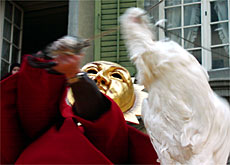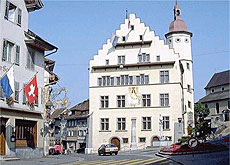Goose gets the chop in Sursee

The Spanish run bulls, the Chinese gamble on cockfights but some Swiss prefer the gruesome yet bizarre custom of beheading a dead goose.
swissinfo’s Dale Bechtel travelled to the town of Sursee in canton Lucerne to watch the age-old ritual, which has to rank as one of the strangest in Europe.
Few foreign visitors to Switzerland have ever seen, let alone heard of, the medieval spectacle of “Gansabhauet” or “Beheading the Goose”, even though it takes place only a short train ride from the tourist town of Lucerne.
If they had, they might have gone to Sursee instead of spending the day shopping for luxury watches in Lucerne, since the memory of this bizarre ritual is likely to keep ticking longer than a SFr10,000 Swiss watch.
Everything about Gansabhauet sounds rather medieval, if not outright barbaric.
The spectacle gets underway in mid-afternoon at the Guild Hall near the Tower of Thieves, long after the goose has been slaughtered.
With the dead goose in position, wannabe executioners draw lots to decide the order in which they will step on to the stage in the town’s central square.
Blindfolded, wearing a red cloak and sun mask, they then take turns to have a whack at the goose with a blunt sword.
Executioners
Of the 8,000 residents of Sursee, about 50 decided this year that it would be a great way to spend a rainy day in chilly November. They included a number of first-timers as well as veterans of the event.
It seems that Gansabhauet gets more popular the more civilised and modern the people of Sursee claim to become. Students, engineers and consultants were among the volunteers.
However, none of the young men I spoke to could explain precisely why they wanted to play the role of goose executioner.
“I don’t really know; I guess because it’s a local tradition,” said some. Others said it was just good fun.
Medieval and modern
But as with many traditions, the spectacle in Sursee is a modern and grand adaptation of what may have been a modest game played by medieval peasants as part of a religious festival.
It is believed the custom stems from celebrations to mark Martin’s Day, when peasants were expected to pay their tithes to the church, and geese were part of the livestock handed over.
The tradition came to an end in the early 19th century for unknown reasons. It was revived in rather modest fashion in 1863, when the local newspaper proclaimed it was the practice of “an age-old custom and very amusing game”.
The golden sun mask and red coat didn’t appear until 1880, and it took another 100 years or so for the guild responsible for upholding the tradition to erect a stage, for the benefit of the bloodthirsty crowds.
At precisely 3pm, the “Heini von Uri” guild leads a procession from the Tower of Thieves to the goose gallows.
Gaudy procession
Guild members beat drums and hold staffs and banners high, but more importantly they carry the slaughtered goose and the costume to be worn by the executioners.
Behind the goose walk the many prominent guests invited by the guild, including the entire town council and wealthy businessmen.
It is as much pomp and pageantry as one can expect in a small Swiss town.
I caught up during the procession with Beatrice Wüst, who is the only female member of the Gansabhauet committee.
Wüst reassured me that the goose was naturally reared and had lived a good life, before being slaughtered in a humane way.
She then proceeded to tell me why the custom was resurrected.
“Guilds no longer represent professions and this association [Heini von Uri] was founded as a carnival guild. Since it considers itself an historical organisation, the members thought it was appropriate to revive this old custom,” explained Wüst.
Sought-after spectacle
It was a popular decision. Wüst says the people of Sursee are proud to uphold such a unique tradition.
Entrance to the town square is free, and thousands crowd around the makeshift stage. Schoolchildren are given the afternoon off to watch the spectacle.
After drinking a glass of red wine for courage, the “blind” executioner is led on to the stage by a member of the guild whose job it is to direct – or misdirect – them to the goose strung up on a wire.
To the constant beat of drums, the crowd cheers and jeers the performance of each masked volunteer as he wanders about the stage trying to locate his victim.
Once found, feathers are plucked from the long white neck and practice swings taken.
Then comes a sudden whack, the flying of more feathers and for a moment, the collective holding of breath to see if the bird has been decapitated.
This year it was a mild-mannered 30-year-old consultant – Executioner Number Nine – who became the hero of Sursee.
His reward: the goose.
swissinfo/Dale Bechtel
The custom takes place in Sursee each year on November 11, Martin’s Day.
It is believed to date back to Middle Ages, when it was part of Martin’s Day festivities.
The naturally-reared goose is slaughtered in a humane way before being strung up.

In compliance with the JTI standards
More: SWI swissinfo.ch certified by the Journalism Trust Initiative


You can find an overview of ongoing debates with our journalists here. Please join us!
If you want to start a conversation about a topic raised in this article or want to report factual errors, email us at english@swissinfo.ch.